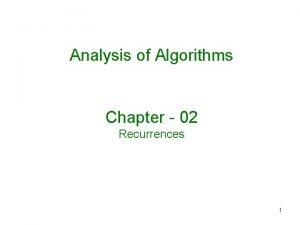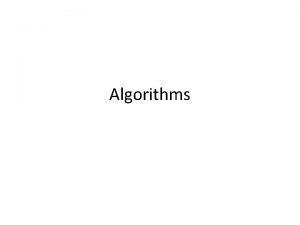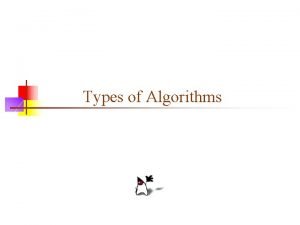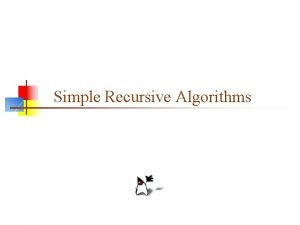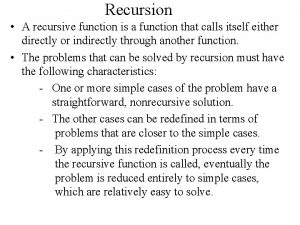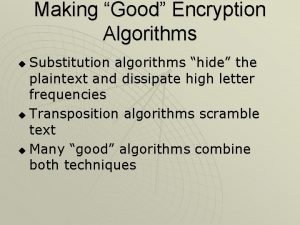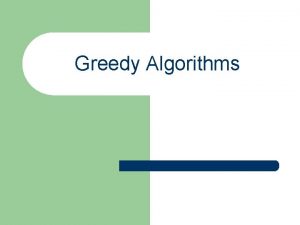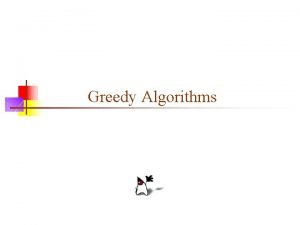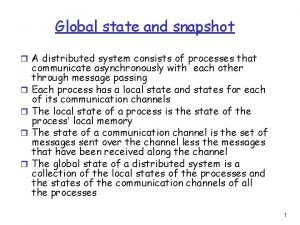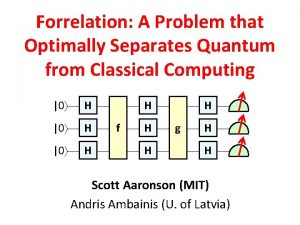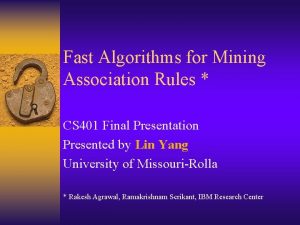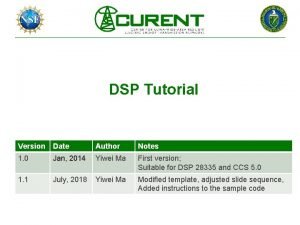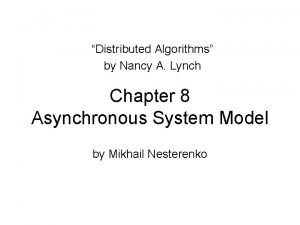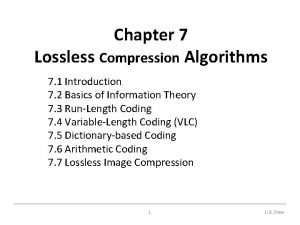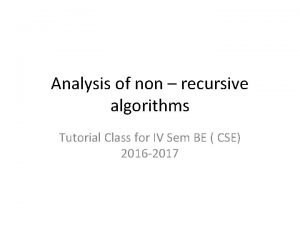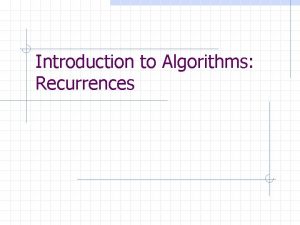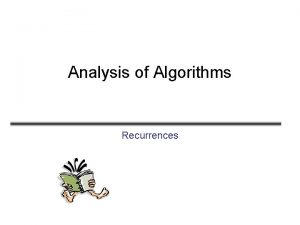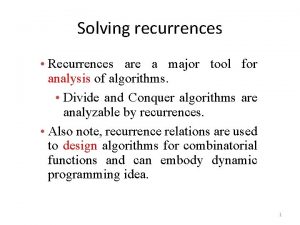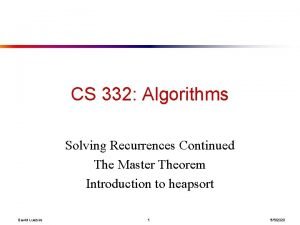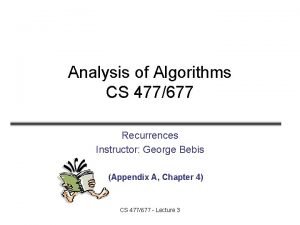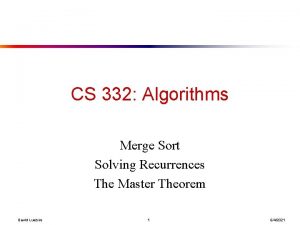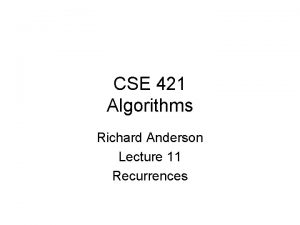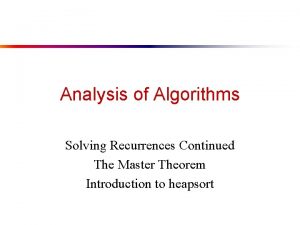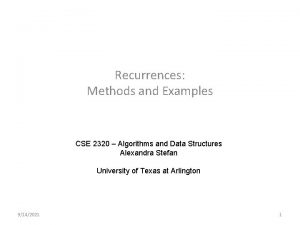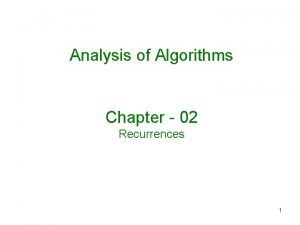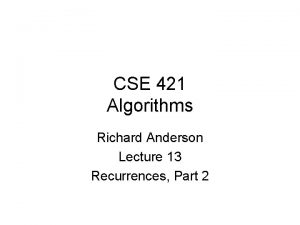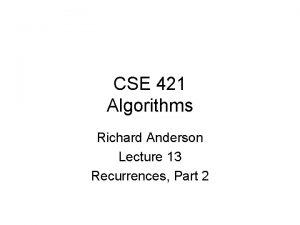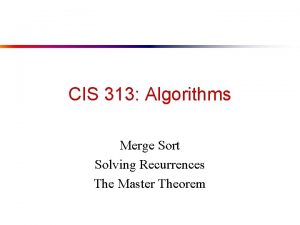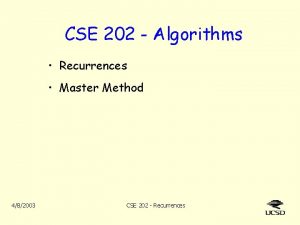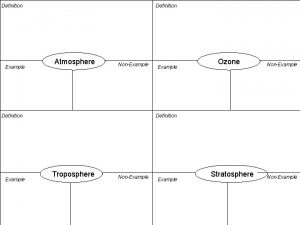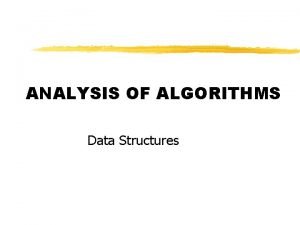Algorithms Recurrences CS 8833 Algorithms Recurrences Definition a





































- Slides: 37

Algorithms Recurrences CS 8833 Algorithms

Recurrences Definition – a recurrence is an equation or inequality that describes a function in terms of its value on smaller inputs l Example – recurrence for Merge-Sort l CS 8833 Algorithms

Why Recurrences? The complexity of many interesting algorithms is easily expressed as a recurrence – especially divide and conquer algorithms l The form of the algorithm often yields the form of the recurrence l The complexity of recursive algorithms is readily expressed as a recurrence. l CS 8833 Algorithms

Why solve recurrences? To make it easier to compare the complexity of two algorithms l To make it easier to compare the complexity of the algorithm to standard reference functions. l CS 8833 Algorithms

Example Recurrences for Algorithms l Insertion sort l Linear search of a list CS 8833 Algorithms

Recurrences for Algorithms, continued l Binary search CS 8833 Algorithms

Casual About Some Details l Boundary conditions – – l These are usually constant for small n We sometimes use these to fill in the details of a “rough guess” solution Floors and ceilings – – Usually makes no difference in solution Usually assume n is an “appropriate” integer (i. e. a power of 2) and assume that the function behaves the same way if floors and ceilings were taken into consideration CS 8833 Algorithms

Merge Sort Assumptions l Actual recurrence is: l But we typically assume that n = 2 k where k is an integer and use the simpler recurrence. CS 8833 Algorithms

Methods for Solving Recurrences Substitution (constructive induction) l Iterating the recurrence l Master Theorem l CS 8833 Algorithms

Substitution Method (Constructive Induction) Use mathematical induction to derive an answer l Steps l 1. Guess the form of the solution 2. Use mathematical induction to find constants or show that they can be found and to prove that the answer is correct CS 8833 Algorithms

Substitution l Goal Derive a function of n (or other variables used to express the size of the problem) that is not a recurrence so we can establish an upper and/or lower bound on the recurrence May get an exact solution or may just get upper or lower bounds on the solution CS 8833 Algorithms

Constructive Induction Suppose T includes a parameter n and n is a natural number (positive integer) l Instead of proving directly that T holds for all values of n, prove l – – T holds for a base case b (often n = 1) For every n > b, if T holds for n-1, then T holds for n. » » Assume T holds for n-1 Prove that T holds for n follows from this assumption CS 8833 Algorithms

Example 1 l Given l Prove T(n) O(n 2) – Note that this is the recurrence for insertion sort and we have already shown that this is O(n 2) using other methods CS 8833 Algorithms

Proof for Example 1 Guess that the solution for T(n) is a quadratic equation l Base case T(1) = a + b + c. We need to find values for a, b, and c first. l Assume this solution holds for n-1 l l Now consider the case for n. Begin with the recurrence for T(n) CS 8833 Algorithms

CS 8833 Algorithms

CS 8833 Algorithms

Example 2– Establishing an Upper Bound CS 8833 Algorithms

CS 8833 Algorithms

CS 8833 Algorithms

Ex. 3–Fallacious Argument CS 8833 Algorithms

Ex. 3–Try again CS 8833 Algorithms

Ex. 3–Try again cont. CS 8833 Algorithms

Boundary Conditions Boundary conditions are not usually important because we don’t need an actual c value (if polynomially bounded) l But sometimes it makes a big difference l – – Exponential solutions Suppose we are searching for a solution to: and we find the partial solution CS 8833 Algorithms

Boundary Conditions cont. CS 8833 Algorithms

Boundary Conditions l The solutions to the recurrences below have very different upper bounds CS 8833 Algorithms

Changing Variables CS 8833 Algorithms

Changing Variables continued CS 8833 Algorithms

Iterating the Recurrence The math can be messy with this method l Can sometimes use this method to get an estimate that we can use for the substitution method l CS 8833 Algorithms

Example 4 CS 8833 Algorithms

CS 8833 Algorithms

CS 8833 Algorithms

Recurrence Trees Allow you to visualize the process of iterating the recurrence l Allows you make a good guess for the substitution method l Or to organize the bookkeeping for iterating the recurrence l Example l CS 8833 Algorithms

n 2 T(n/2)2 n 2 (n/2)2 T(n/4) CS 8833 Algorithms (n/2)2 (n/4)2

Counting things CS 8833 Algorithms

Recurrence Tree Example n 2 (n/2)2 lg n (n/4)2 CS 8833 (n/4)2 Algorithms (n/4)2 Total: (n 2)

Another Example CS 8833 Algorithms

n 2 T(n/4) n 2 T(n/2) (n/4)2 n 2 (n/2)2 T(n/16) T(n/8) T(n/4) 5/16 n 2 25/256 n 2=(5/16)2 n 2 Since the values decrease geometrically, the total is at most a constant factor more than the largest term and hence the solution is n 2) CS 8833 Algorithms
 Solving recurrences substitution method
Solving recurrences substitution method Master method for solving recurrences
Master method for solving recurrences Master method
Master method Recurrences
Recurrences Defination of algorithm
Defination of algorithm Computational thinking algorithms and programming
Computational thinking algorithms and programming Types of algorithm
Types of algorithm List of recursive algorithms
List of recursive algorithms 1001 design
1001 design Safe patient handling algorithms
Safe patient handling algorithms Recursive algorithms
Recursive algorithms Types of randomized algorithms
Types of randomized algorithms Process mining algorithms
Process mining algorithms Evolutionary algorithms ppt
Evolutionary algorithms ppt Nature-inspired learning algorithms
Nature-inspired learning algorithms Metaheuristic algorithms
Metaheuristic algorithms Making good encryption algorithms
Making good encryption algorithms Algorithm analysis examples
Algorithm analysis examples Statistical algorithms
Statistical algorithms Professor ajit diwan
Professor ajit diwan Advantage and disadvantage of greedy algorithm
Advantage and disadvantage of greedy algorithm Greedy algorithm list
Greedy algorithm list Snapshot algorithm for fifo channels
Snapshot algorithm for fifo channels Forrelation
Forrelation Fast algorithms for mining association rules
Fast algorithms for mining association rules Dsp programming tutorial
Dsp programming tutorial Distributed algorithms nancy lynch
Distributed algorithms nancy lynch How to analyze algorithm
How to analyze algorithm Association analysis: basic concepts and algorithms
Association analysis: basic concepts and algorithms Virtual web view in web mining
Virtual web view in web mining Fftooo
Fftooo Cos 423 princeton
Cos 423 princeton Algorithms in computer networks
Algorithms in computer networks Data structures and algorithms tutorial
Data structures and algorithms tutorial Lossless compression algorithms in multimedia
Lossless compression algorithms in multimedia Memory management algorithms
Memory management algorithms Raster graphics algorithms
Raster graphics algorithms Summarize the general plan for non-recursive algorithms.
Summarize the general plan for non-recursive algorithms.

